Brigham Young
| Brigham Young | |
|---|---|
|
Brigham Young c. 1870 | |
| 2nd President of The Church of Jesus Christ of Latter-day Saints | |
| December 27, 1847 – August 29, 1877 | |
| Predecessor | Joseph Smith |
| Successor | John Taylor |
| President of the Quorum of the Twelve Apostles | |
| April 14, 1840 – December 27, 1847 | |
| End reason | Became President of the Church |
| Quorum of the Twelve Apostles | |
| February 14, 1835 – December 27, 1847 | |
| Called by | Three Witnesses |
| End reason | Became President of the Church |
| LDS Church Apostle | |
| February 14, 1835 – August 29, 1877 | |
| Called by | Three Witnesses |
| Reason | Initial organization of Quorum of the Twelve |
| Reorganization at end of term | No apostles immediately ordained[1] |
| Governor of Utah Territory | |
| In office | |
| February 3, 1851 – April 12, 1858 | |
| Successor | Alfred Cumming |
| Personal details | |
| Born |
June 1, 1801 Whitingham, Vermont, United States |
| Died |
August 29, 1877 (aged 76) Salt Lake City, Utah Territory, United States |
| Cause of death | Ruptured appendix |
| Resting place |
Brigham Young Cemetery 40°46′13″N 111°53′08″W / 40.7703°N 111.8856°W |
| Spouse(s) | See List of Brigham Young's wives |
| Children | 56[2] |
| Parents | John and Abigail Young |
| Website | brighamyoung.org |
| Signature | |
 | |
Brigham Young (/ˈbrɪɡəm/; June 1, 1801 – August 29, 1877) was an American leader in the Latter Day Saint movement and a settler of the Western United States. He was the second President of The Church of Jesus Christ of Latter-day Saints (LDS Church) from 1847 until his death in 1877. He founded Salt Lake City and he served as the first governor of the Utah Territory. Young also led the foundings of the precursors to the University of Utah and Brigham Young University.
Young had many nicknames, among the most popular being "American Moses"[3] (alternatively, the "Modern Moses" or "Mormon Moses"),[4][5] because, like the biblical figure, Young led his followers, the Mormon pioneers, in an exodus through a desert, to what they saw as a promised land.[6] Young was dubbed by his followers the "Lion of the Lord" for his bold personality and was also commonly called "Brother Brigham" by Latter-day Saints. Young was a polygamist and was involved in controversies regarding black people and the Priesthood, the Utah War, and the Mountain Meadows massacre.
Early life and succession to Latter Day Saint leadership
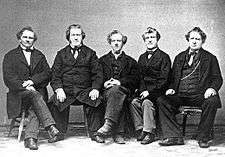
From left to right: Lorenzo Dow, Brigham, Phineas H., Joseph, and John.
Young was born to John Young and Abigail "Nabby" Howe, a farming family in Whitingham, Vermont, and worked as a travelling carpenter and blacksmith, among other trades.[7] Young was first married in 1824 to Miriam Angeline Works. Though he had converted to the Methodist faith in 1823, Young was drawn to Mormonism after reading the Book of Mormon shortly after its publication in 1830. He officially joined the new church in 1832 and traveled to Upper Canada as a missionary. After his wife died in 1832, Young joined many Mormons in establishing a community in Kirtland, Ohio. Young was ordained a member of the original Quorum of the Twelve Apostles in 1835, and he assumed a leadership role within that organization in taking Mormonism to the United Kingdom and organizing the exodus of Latter Day Saints from Missouri in 1838.
In 1844, while in jail awaiting trial for treason charges, Joseph Smith, president of the church, was killed by an armed mob. Several claimants to the role of church president emerged during the succession crisis that ensued. Before a large meeting convened to discuss the succession in Nauvoo, Illinois, Sidney Rigdon, the senior surviving member of the church's First Presidency, argued there could be no successor to the deceased prophet and that he should be made the "Protector" of the church.[8] Young opposed this reasoning and motion. Smith had earlier recorded a revelation which stated the Quorum of the Twelve Apostles was "equal in authority and power" to the First Presidency,[9] so Young claimed that the leadership of the church fell to the Twelve Apostles.[10] The majority in attendance were persuaded that the Quorum of the Twelve Apostles was to lead the church with Young as the Quorum's president. Many of Young's followers would later reminisce that while Young spoke to the congregation, he looked or sounded exactly like Smith, which they attributed to the power of God.[11][12][13][14] Young was ordained President of the Church in December 1847, three and a half years after Smith's death. Rigdon became the president of a separate church organization based in Pittsburgh, Pennsylvania, and other potential successors emerged to lead what became other denominations of the movement.
Migration west
Repeated conflict led Young to relocate his group of Latter-day Saints to the Salt Lake Valley, which was then part of Mexico. Young organized the journey that would take the Mormon pioneers to Winter Quarters, Nebraska, in 1846, then to the Salt Lake Valley. By the time Young arrived at the final destination, it had come under American control as a result of war with Mexico, although U.S. sovereignty would not be confirmed until 1848. Young arrived in the Salt Lake Valley on July 24, 1847, a date now recognized as Pioneer Day in Utah. Young's expedition was one the largest and one of the best organized westward treks.[15] On August 22, 29 days after arriving in the Salt Lake Valley, Young organized the Mormon Tabernacle Choir.[16]
After three years of leading the church as the President of the Quorum of the Twelve Apostles, Young reorganized a new First Presidency and was declared president of the church on December 27, 1847.
Governor of Utah Territory
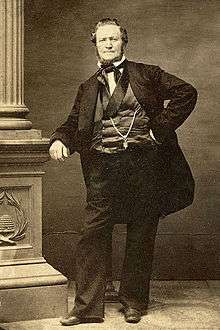
As colonizer and founder of Salt Lake City, Young was appointed the territory's first governor and superintendent of American Indian affairs by President Millard Fillmore on February 3, 1851.[17] During his time as governor, Young directed the establishment of settlements throughout present-day Utah, Idaho, Arizona, Nevada, California and parts of southern Colorado and northern Mexico. Under his direction, the Mormons built roads and bridges, forts, irrigation projects; established public welfare; organized a militia; issued an extermination order against the Timpanogos and after a series of wars eventually made peace with the Native Americans. Young was also one of the first to subscribe to Union Pacific stock, for the construction of the First Transcontinental Railroad. Young organized the first legislature and established Fillmore as the territory's first capital.
Young organized a Board of Regents to establish a university in the Salt Lake Valley.[18] It was established on February 28, 1850, as the University of Deseret; its name was eventually changed to the University of Utah.
In 1851, Young and several federal officials, including territorial Secretary Broughton Harris, became unable to work cooperatively. Harris and the others departed Utah without replacements being named, and these individuals later became known as the Runaway Officials of 1851.[19]
In 1852, Young led the efforts to legalize slavery in Utah, based on Mormon beliefs on slavery.[20][21]
In 1856, Young organized an efficient mail service. In 1858, following the events of the Utah War, he stepped down to his successor Alfred Cumming.[22]
Church Presidency
Young was the longest serving President of the LDS Church in history, having served for 29 years.
Educational endeavors
Having previously established the University of Deseret during his tenure as governor, on October 16, 1875, Young personally purchased land in Provo, Utah, to extend the reach of the University of Deseret.[23] Young said, "I hope to see an Academy established in Provo ... at which the children of the Latter-day Saints can receive a good education unmixed with the pernicious atheistic influences that are found in so many of the higher schools of the country."[24] The school broke off from the University of Deseret and became Brigham Young Academy,[24] the precursor to Brigham Young University.
Within the church, Young reorganized the Relief Society for women (1867), and he created organizations for young women (1869) and young men (1875).
Temple building
Young was involved in temple building throughout his membership in the LDS Church and made temple building a priority of his church presidency. Under Smith's leadership, Young participated in the building of the Kirtland and Nauvoo temples. Just four days after arriving in the Salt Lake Valley, Young designated the location for the Salt Lake Temple; he presided over its groundbreaking on April 6, 1853.[25] During his tenure, Young oversaw construction of the Salt Lake Tabernacle and he announced plans to build the St. George (1871), Manti (1875), and Logan (1877) temples. He also provisioned the building of the Endowment House, a "temporary temple" which began to be used in 1855 to provide temple ordinances to church members while the Salt Lake Temple was under construction.
Controversial teachings
| Mormonism and polygamy |
|---|
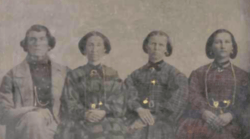 Portrait of Ira Eldredge with his three wives: Nancy Black Eldredge, Hannah Mariah Savage Eldredge, and Helvig Marie Andersen Eldredge. |
|
Related articles |
|
|
Though polygamy was practiced by Young's predecessor Joseph Smith, the practice is often associated with Young. Some Latter Day Saint denominations, such as the Community of Christ, consider Young the "Father of Mormon Polygamy".[26] In 1853, Young made the church's first official statement on the subject since the church had arrived in Utah. He spoke about the issue nine years after the purported original revelation of Smith, and five years after the Mormon Exodus to Utah.
One of the more controversial teachings of Young was the Adam–God doctrine. According to Young, he was taught by Smith that Adam is "our Father and our God, and the only God with whom we have to do". According to the doctrine, Adam was once a mortal man who became resurrected and exalted. From another planet, Adam brought Eve, one of his wives, with him to the earth, where they became mortal by eating the fruit of the Garden of Eden. After bearing mortal children and establishing the human race, Adam and Eve returned to their heavenly thrones where Adam acts as the god of this world. Later, as Young is generally understood to have taught, Adam returned to the earth to become the biological father of Jesus.[27][28][29] The LDS Church has since repudiated the Adam–God doctrine.[30]
Young is generally considered to have instituted a church ban against conferring the priesthood on men of black African descent, who had been treated equally in this respect under Joseph Smith's presidency.[31] After settling in Utah in 1848, Young announced the ban,[31] which also forbade blacks from participating in Mormon temple rites such as the endowment or sealings. On many occasions, Young taught that blacks were denied the priesthood because they were "the seed of Cain",[32] but also stated that they would eventually receive the priesthood after "all the other children of Adam have the privilege of receiving the Priesthood, and of coming into the kingdom of God, and of being redeemed from the four quarters of the earth, and have received their resurrection from the dead, then it will be time enough to remove the curse from Cain and his posterity."[33] In 1863, Young stated "Shall I tell you the law of God in regard to the African race? If the white man who belongs to the chosen seed mixes his blood with the seed of Cain, the penalty, under the law of God, is death on the spot. This will always be so."[34] These racial restrictions remained in place until 1978, when the policy was rescinded by LDS Church president Spencer W. Kimball,[35] and the LDS Church subsequently "disavow[ed] theories advanced in the past" to explain this ban,[36] thereby "plac[ing] the origins of black priesthood denial blame squarely on Brigham Young."[37]
Conflicts
Shortly after the arrival of Young's pioneers, the new Mormon colonies were incorporated into the United States through the Mexican Cession. Young petitioned the U.S. Congress to create the State of Deseret. The Compromise of 1850 instead carved out Utah Territory and Young was installed as governor. As governor and church president, Young directed both religious and economic matters. He encouraged independence and self-sufficiency. Many cities and towns in Utah, and some in neighboring states, were founded under Young's direction. Young's leadership style has been viewed as autocratic.[38] When federal officials received reports of widespread and systematic obstruction of federal officials in Utah (most notably judges), U.S. President James Buchanan decided to install a non-Mormon governor. Buchanan accepted the reports of the judges without any further investigation, and the new non-sectarian governor was accompanied by troops sent to garrison forts in the new territory. The troops passed by the bloody Kansas–Missouri war without intervening in it, as it was not open warfare and only isolated sporadic incidents. When Young received word that federal troops were headed to Utah with his replacement, he called out his militia to ambush the federal force. During the defense of Utah, now called the Utah War, Young held the U.S. Army at bay for a winter by taking their cattle and burning supply wagons. The Mormon forces were largely successful thanks to Lot Smith. Young made plans to burn Salt Lake City and move his followers to Mexico, but at the last minute he relented and agreed to step down as governor . He later received a pardon from Buchanan. Relations between Young and future governors and U.S. Presidents were mixed.
The degree of Young's involvement in the Mountain Meadows massacre, which took place in Washington County in 1857, is disputed.[39] Leonard J. Arrington reports that Young received a rider at his office on the day of the massacre, and that when he learned of the contemplated attack by the members of the LDS Church in Parowan and Cedar City, he sent back a letter directing that the Fancher party be allowed to pass through the territory unmolested.[40] Young's letter reportedly arrived on September 13, 1857, two days after the massacre. As governor, Young had promised the federal government he would protect immigrants passing through Utah Territory, but over 120 men, women and children were killed in this incident. There is no debate concerning the involvement of individual Mormons from the surrounding communities by scholars. Only children under the age of seven, who were cared for by local Mormon families, survived, and the murdered members of the wagon train were left unburied. The remains of about forty people were later found and buried, and Union Army officer James Henry Carleton had a large cross made from local trees, the transverse beam bearing the engraving, "Vengeance Is Mine, Saith The Lord: I Will Repay" and erected a cairn of rocks at the site. A large slab of granite was put up on which he had the following words engraved: "Here 120 men, women and children were massacred in cold blood early in September, 1857. They were from Arkansas." For two years the monument stood as a memorial to those travelling the Spanish Trail through Mountain Meadow. Some claim that, in 1861, Young brought an entourage to Mountain Meadows and had the cairn and cross destroyed, while exclaiming, "Vengeance is mine and I have taken a little".[41]
Death
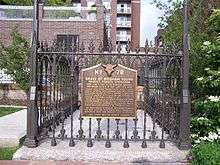
Before his death in Salt Lake City on August 29, 1877,[42] Young was suffering from cholera morbus and inflammation of the bowels.[43] It is believed that he died of peritonitis from a ruptured appendix.[2] His last words were "Joseph! Joseph! Joseph!", invoking the name of the late Joseph Smith, founder of the Mormon faith.[44] On September 2, 1877, Young's funeral was held in the Tabernacle with an estimated 12,000 to 15,000 people in attendance.[45] He is buried on the grounds of the Mormon Pioneer Memorial Monument in the heart of Salt Lake City. A bronze marker was placed at the grave site June 10, 1938, by members of the Young Men and Young Women organizations, which he founded.[46]
Legacy
Impact
A century after his death, one writer stated that
[Joseph Smith] was succeeded by one of the outstanding organizers of the 19th century, Brigham Young. If the circumstances of his life had worked out differently [he] might have become a captain of industry—an Andrew Carnegie or John D. Rockefeller or a railroad builder. Instead, this able, energetic, earthy man became the absolute ruler and the revered, genuinely loved father figure of all Mormons everywhere.[47]
He credited Young's leadership with helping to settle much of the American West: During the 30 years between the Mormons' arrival in Utah in 1847 and [his death in] 1877, Young directed the founding of 350 towns in the Southwest. Thereby the Mormons became the most important single agency in colonizing that vast arid West between the Rockies and the Sierra Nevada.[47]
Memorials to Young include a bronze statue in front of the Abraham O. Smoot Administration Building, Brigham Young University; a marble statue in the National Statuary Hall Collection at the United States Capitol, donated by the State of Utah in 1950;[48] and a statue atop the This is the Place Monument in Salt Lake City.

Young's teachings were the 1998–99 course of study in the LDS Church's Sunday Relief Society and Melchizedek priesthood classes.
Family and descendants
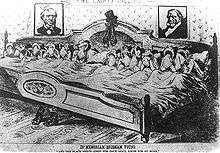
Young was a polygamist, marrying a total of 55 wives, 54 of them after he converted to Mormonism.[49] The policy was difficult for many in the church. Young stated that upon being taught about plural marriage, "It was the first time in my life that I desired the grave."[50] By the time of his death, Young had 56 children by 16 of his wives; 46 of his children reached adulthood.[2]
Sources have varied on the number of Young's wives, due to differences in what scholars have considered to be a "wife".[49] There were 55 women that Young was sealed to during his lifetime. While the majority of the sealings were "for eternity", some were "for time only". Researchers believe that not all of the 55 marriages were conjugal.[49] Young did not live with a number of his wives or publicly hold them out as wives, which has led to confusion on the number and identities.[49] This is in part due to the complexity of how wives were identified in the Mormon society at the time.
| “ | Young's ability to keep [dozens of] wives from quarreling and so many children from overwhelming him would in itself prove that [he] must have been a remarkable, not to say a master, diplomat.[47] | ” |
Of Young's 55 wives, 21 had never been married before; 16 were widows; six were divorced; six had living husbands; and the marital status of six others are unknown.[49] In 1856, Young built the Lion House to accommodate his sizable family. This building remains a Salt Lake City landmark, together with the Beehive House, another Young family home. A contemporary of Young wrote: "It was amusing to walk by Brigham Young's big house, a long rambling building with innumerable doors. Each wife has an establishment of her own, consisting of parlor, bedroom, and a front door, the key of which she keeps in her pocket."[51] At the time of Young's death, 19 of his wives had predeceased him, he was divorced from ten, and 23 survived him. The status of four was unknown.[49] One of his wives, Zina Huntington Young, served as the third president of the Relief Society. In his will, Young shared his estate with the 16 surviving wives who had lived with him; the six surviving non-conjugal wives were not mentioned in the will.[49]
Notable descendants
In 1902, 25 years after his death, The New York Times established that Young's direct descendants numbered more than 1,000.[52] Some of Young's descendants have become leaders in the LDS Church, while other have become notable for events outside of LDS Church service.
Fictional references
In literature
Florence Claxton's graphic novel, The Adventures of a Woman in Search of her Rights (1872), satirizes a would-be emancipated woman whose failure to establish an independent career results in her marriage to Young before she wakes to discover she's been dreaming.
Arthur Conan Doyle based his first Sherlock Holmes novel, A Study in Scarlet, on Mormon history, mentioning Young by name. When asked to comment on the story, which had "provoked the animosity of the Mormon faithful", Doyle noted, "all I said about the Danite Band and the murders is historical so I cannot withdraw that though it is likely that in a work of fiction it is stated more luridly than in a work of history." Doyle's daughter stated: "You know father would be the first to admit that his first Sherlock Holmes novel was full of errors about the Mormons."[53]
Mark Twain devoted a chapter and much of an appendix to Young in Roughing It.
In television
Byron Morrow played Young in a cameo appearance in the Death Valley Days episode, "An Organ for Brother Brigham" (1966). In the storyline, the organ built and guided west to Salt Lake City by Joseph Harris Ridges (1827-1914) of Australia becomes mired in the sand. Wagonmaster Luke Winner (portrayed Morgan Woodward) feels compelled to leave the instrument behind until Ridges finds solid rock under the sand.[54]
Gregg Henry depicts Young in the fourth (2014) and fifth (2015) seasons of the TV series Hell on Wheels, a fictional story about the construction of the First Transcontinental Railroad. As the competing rail lines approach Utah from the east and west coasts, Young supplies Mormon laborers to both railroad companies and negotiates with the railways to have them make Salt Lake City their meeting point. In the Season 5 mid-season finale, "False Prophets," Young's son, Phineas, attempts to murder his father. Persuaded by The Swede, Phineas believed he was the chosen one to go forward to lead the Mormons, instead of his father.
Literary works
Since Young's death, a number of works have published collections of his discourses and sayings.
- Teachings of President Brigham Young: Salvation for the Dead, the Spirit World, and Kindred Subjects. Seagull Press. 1922.
- Brigham Young (1925). Discourses of Brigham Young. selected by John A. Widtsoe. Deseret Book.
- Young, Brigham (1952). The Best from Brigham Young: Statements from His Sermons on Religion, Education, and Community Building. selected by Alice K. Chase. Deseret Book Company.
- Manuscript History of Brigham Young, 1801–1844. Eldon J. Watson. 1969.
- Manuscript History of Brigham Young, 1846–1847. Eldon J. Watson. 1971.
- Dean C. Jessee, ed. (1974). Letters of Brigham Young to His Sons. Deseret Book Company.
- Everett L. Cooley, ed. (1980). Diary of Brigham Young, 1857. Tanner Trust Fund, University of Utah Library.
- The Essential Brigham Young. Signature Books. 1992. ISBN 1-56085-010-8.
- Teachings of Presidents of the Church: Brigham Young. The Church of Jesus Christ of Latter-day Saints. 1997. LDS Church publication number 35554
- Young, Brigham (2009). Richard Van Wagoner, ed. The Complete Discourses of Brigham Young. 5. Smith-Pettit Foundation. ISBN 978-1-56085-206-3.
See also
- Brigham Young (1940 film)
- Brigham Young Winter Home and Office
- Richards–Young family
- This Is The Place Heritage Park
- Ann Eliza Young[11]
Notes
- ↑ A year after Young's death, Orson Hyde died and Moses Thatcher was ordained an apostle. The First Presidency was not reorganized until October 10, 1880, after which Francis M. Lyman and John Henry Smith were ordained. Orson Pratt died in 1881, and the Quorum of the Twelve did not have twelve members again until October 16, 1882, when George Teasdale and Heber J. Grant were ordained.
- 1 2 3 "Brigham Young Biography: Facts of Faith", Y Facts, BYU
- ↑ "Topics and Background: Topic – Brigham Young", Newsroom (MormonNewsroom.org), LDS Church
- ↑ Gibbons, Francis M. (1981), Brigham Young: Modern Moses, Prophet of God, Salt Lake City, Utah: Deseret Book, ISBN 978-0877478584
- ↑ Steorts, Jason Lee (October 29, 2012), "The Mormon Moses", National Review
- ↑ Nelson, Russell M. (July 1999), "The Exodus Repeated", Ensign,
Many instructive parallels exist between the exodus from Egypt of the Israelites under Moses and the exodus from the United States of the Latter-day Saint pioneers under Brigham Young. We can learn much from these stalwarts of ancient and modern Israel.
- ↑ Sheret, John G. (Fall 2006 – Winter 2007), Brigham Young: Carpenter and Cabinet Maker (141), The Crooked Lake Review
- ↑ Roberts, B. H. (ed.), "XVIII", History of the Church, 7
- ↑ Doctrine and Covenants 107:23-24
- ↑ Roberts, B. H. (ed.), "XIX", History of the Church, 7
- 1 2 Quinn, D. Michael (1994). The Mormon Hierarchy: Origins of Power. Signature Books. p. 166. ISBN 1-56085-056-6.; Harper 1996; Jorgensen, Lynne Watkins (2005), "The Mantle of the Prophet Joseph Smith Passes to Brother Brigham: One Hundred Twenty-one Testimonies of a Collective Spiritual Witness", in Welch, John W., Opening the Heavens: Accounts of Divine Manifestations, 1820–1844, Provo, Utah: BYU Press, pp. 374–480; England, Eugene (Winter 1978), "George Laub's Nauvoo Journal", BYU Studies, 18: 16,
Now when President Young arose to address the congregation his voice was the voice of Bro[ther] Joseph and his face appeared as Joseph's face & should I have not seen his face but heard his voice I should have declared that it was Joseph. [spelling and punctuation normalized]
; Burton, William, William Burton Diary, May 1845, LDS Church Archives,But their [Joseph Smith and Hyrum Smith's] places were filed by others much better than I once supposed they could have been, the spirit of Joseph appeared to rest upon Brigham"
; Johnson, Benjamin F. (1928), My Life's Review, Independence, pp. 103–104,But as soon as he spoke I jumped upon my feet, for in every possible degree it was Joseph's voice, and his person, in look, attitude, dress and appearance; [it] was Joseph himself, personified and I knew in a moment the spirit and mantle of Joseph was upon him"
; Life Story of Mosiah Hancock, BYU Library, p. 23,Although only a boy, I saw the mantle of the Prophet Joseph rest upon Brigham Young; and he arose lion-like to the occasion and led the people forth
; Woodruff, Wilford (March 15, 1892), "none", Deseret News,If I had not seen him with my own eyes, there is no one that could have convinced me that it was not Joseph Smith
; Cannon, George Q. (October 29, 1870), Juvenile Instructor, 5 (22): 174–175,When Brigham Young spoke it was with the voice of Joseph himself; and not only was it the voice of Joseph which was heard, but it seemed in the eyes of the people as though it was the every person of Joseph which stood before them
- ↑ However, historians have come to different conclusions on whether the occurrence of such events is supported by contemporary records. Van Wagoner observed of contemporary accounts that "none of these references an explicit transfiguration, a physical metamorphosis of Brigham Young into the form and voice of Joseph Smith," and "[w]hen 8 August 1844 is stripped of emotional overlay, there is not a shred of irrefutable contemporary evidence to support the occurrence of a mystical event either in the morning or afternoon gatherings of that day.": Van Wagoner, Richard S. (Winter 1995). "The Making of a Mormon Myth: The 1844 Transfiguration of Brigham Young". Dialogue: A Journal of Mormon Thought. 28 (4): 1–24.
- ↑ Jorgenson, Lynne W. (1996–97). "The Mantle of the Prophet Joseph Passes to Brother Brigham: A Collective Spiritual Witness". BYU Studies. 36 (4): 125–204.
- ↑ Arrington, Leonard J. (1986). Brigham Young: American Moses. University of Illinois Press. pp. 114–115. ISBN 0-252-01296-8.
- ↑ "Brigham Young". historytogo.utah.gov. Retrieved 2016-02-29.
- ↑ "Frequently Asked Questions – When was the Mormon Tabernacle Choir formed?", Mormontabernaclechoir.org, Mormon Tabernacle Choir, archived from the original on 2013-03-29
- ↑ "Utah's new capitol grows from humble beginning; first political sessions were held in council house; fight for statehood". Salt Lake Telegram. October 22, 1916. Retrieved May 14, 2010.
- ↑ Ison, Yvette D. (January 1995), "The Beginnings of the University of Utah", History Blazer, Utah State Historical Society. Online reprint, with permission, at HistoryToGo.utah.gov by the Utah Division of State History, Utah Department of Heritage and Arts, State of Utah.
- ↑ Randal S. Chase, Church History Study Guide, Part 3, 2012, p. 85.
- ↑ Utah Legislative Assembly (1852). Journals of the Legislative Assembly of the Territory of Utah, of the ... Annual Session, for the Years ..., Volume 1. pp. 108–110.
- ↑ Young, Brigham (1987), Collier, Fred C., ed., The Teachings of President Brigham Young: Vol. 3 1852–1854, Salt Lake City, Utah: Colliers Publishing Company, pp. 26–28, ISBN 0934964017, OCLC 18192348,
Inasmuch as we believe in the ordinances of God, in the Priesthood and order and decrees of God, we must believe in slavery
- ↑ Brigham Young, Utah State Archives
- ↑ Page, Russ (January 12, 2008), "BYU: The "almost" college of Draper, Utah", russpage.net (blog), archived from the original on October 21, 2014
- 1 2 Bills, Sarah (April 16, 2003). "Warren Dusenberry (1875–1876)". The Universe (BYU). BYU NewsNet. Archived from the original on 2012-02-07.
- ↑ Hanks, Marion Duff (1992), "Salt Lake Temple", in Ludlow, Daniel H, Encyclopedia of Mormonism, New York: Macmillan Publishing, pp. 1252–1254, ISBN 0-02-879602-0, OCLC 24502140
- ↑ Richard and Pamela Price (2000), "Vol.1, Ch.4: Brigham Young: The Father of Mormon Polygamy", Joseph Smith Fought Polygamy: How Men Nearest the Prophet Attached Polygamy to His Name in Order to Justify Their Own Polygamous Crimes (self-published), Independence, Missouri: Price Publishing Company, ISBN 1891353063, LCCN 99041763, OCLC 42027453
- ↑ Widmer, Kurt (2000), Mormonism and the Nature of God: A Theological Evolution, 1830–1915, Jefferson, N.C.: McFarland, p. 131.
- ↑ Gary James Bergera, "The Orson Pratt–Brigham Young Controversies: Conflict Within the Quorums, 1853 to 1868", Dialogue: A Journal of Mormon Thought 13(2):7–49 (1980) at p. 41.
- ↑ Boyd Kirkland, "Jehovah as the Father: The Development of the Mormon Jehovah Doctrine", Sunstone 44:36–44 (1984) at p. 39 (Adam "later begot Jesus, his firstborn spirit son, in the flesh").
- ↑ Spencer W. Kimball, "Our Own Liahona," Ensign, November 1976, p. 77 ("We denounce that theory and hope that everyone will be cautioned against this and other kinds of false doctrine.").
- 1 2 Bush, Lester E., Jr.; Mauss, Armand L. (1984). "Chapter 3: Mormonism's Negro Doctrine: An Historical Overview". Neither White nor Black: Mormon Scholars Confront the Race Issue in a Universal Church. Midvale, Utah: Signature Books. pp. 54–65, 70. ISBN 978-0-941214-22-3.
- ↑ Bush, Lester E. (Spring 1973), Mormonism’s Negro Doctrine: An Historical Overview, Dialogue, pp. 54–97, retrieved December 17, 2013
- ↑ Journal of Discourses, 2, p. 142
- ↑ Journal of Discourses, 10, p. 110. See also: miscegenation.
- ↑ "Official Declaration 2", Doctrine and Covenants
- ↑ "Gospel Topics – Race and the Priesthood", LDS.org, LDS Church
- ↑ "The Mormon Church Disavows Its Racist Past But Still Offers No Apology". Huffington Post. Retrieved December 17, 2013.
- ↑ "Brigham Young", Encarta, archived from the original on 2009-10-31.
- ↑ Eakin, Emily (October 12, 2002). "Reopening a Mormon Murder Mystery; New Accusations That Brigham Young Himself Ordered an 1857 Massacre of Pioneers". New York Times (Late Edition-Final ed.). p. Section B, Page 9, Column 2.
- ↑ Brigham Young to Isaac C. Haight, Sept. 10, 1857, Letterpress Copybook 3:827–28, Brigham Young Office Files, LDS Church Archives
- ↑ Sally Denton (2003). American Massacre: The Tragedy at Mountain Meadows, September 1857 (New York: Vintage Books, ISBN 0-375-72636-5) p. 210.
- ↑ "Death of Brigham Young", The New York Times, August 30, 1877.
- ↑ "Brigham Young's Health", The New York Times, August 29, 1877.
- ↑ Quinn, D. Michael (August 1977), "Brigham Young: Man of the Spirit", Ensign
- ↑ "Brigham Young's Funeral", The New York Times, September 3, 1877.
- ↑ "Grave of Brigham Young". State of Utah. Archived from the original on September 21, 2013. Retrieved October 17, 2011.
- 1 2 3 Paul, Rodman W. (December 1974 – January 1975), "The Mormons of Yesterday and Today" (PDF), Engineering and Science, California Institute of Technology & Alumni Association, 38 (2): 12–27, retrieved 2013-09-19
- ↑ "Art: Sculpture – Statues: Brigham Young", Explore Capitol Hill, Architect of the Capitol
- 1 2 3 4 5 6 7 Johnson, Jeffrey Odgen (Fall 1987), "Determining and Defining 'Wife' — The Brigham Young Households", Dialogue: A Journal of Mormon Thought, 20 (3): 57–70
- ↑ "People & Events – Polygamy and the Church: A History", The Mormons, PBS, April 30, 2007, retrieved 2013-09-19
- ↑ DeHegermann-Lindencrone, Lillie. "The Sunny Side of Diplomatic Life, 1875–1912". Project Gutenberg. Retrieved July 18, 2006.
- ↑ "Descendants of Brigham Young to Hold Annual Mass Meetings", New York Times, 1902-06-22.
- ↑ Schindler, Harold (April 10, 1994), "The Case Of The Repentant Writer: Sherlock Homes' Creator Raises The Wrath Of Mormons", The Salt Lake Tribune, p. D1, Archive Article ID: 101185DCD718AD35 (NewsBank). Online reprint Archived September 23, 2006, at the Wayback Machine., with permission, at HistoryToGo.utah.gov by the Utah Division of State History, Utah Department of Heritage and Arts, State of Utah.
- ↑ "An Organ for Brother Brigham on Death Valley Days". Internet Movie Data Base. April 28, 1966. Retrieved September 10, 2015.
References
- Arrington, Leonard J., Brigham Young: American Moses; University of Illinois Press; ISBN 0-252-01296-8, (1985; Paperback, 1986).
- Nibley, Hugh W. (1994). Brother Brigham Challenges the Saints (The Collected Works of Hugh Nibley, vol. 13). Salt Lake City, Utah: Shadow Mountain Pub. ISBN 0-87579-818-7., republished online at Brother Brigham Challenges the Saints by Hugh W. Nibley. FARMS. Retrieved April 28, 2009..
- Bergera, Gary James, Conflict in the Quorum: Orson Pratt, Brigham Young, Joseph Smith
- Cannon, Frank J.; Knapp, George L. (1913). Brigham Young and His Mormon Empire. New York: Fleming H. Revell Co.
- Tullidge, Edward W. (1877). Life of Brigham Young: Or, Utah and Her Founders. New York: Tullidge & Crandall.
- Turner, John G. Brigham Young: Pioneer Prophet. Cambridge, MA: Belknap, 2012.
- Waite, C.V. (Catherine Van Valkenburg) (1868). The Mormon prophet and his harem: or, An authentic history of Brigham Young, his numerous wives and children. Chicago: J.S. Goodman & Co.. See also: The Mormon Prophet and His Harem.
- Young, Brigham (April 9, 1852). "Self-Government — Mysteries — Recreation and Amusements, not in Themselves Sinful — Tithing — Adam, Our Father and Our God". In Watt, G.D. Journal of Discourses by Brigham Young, President of the Church of Jesus Christ of Latter-Day Saints, His Two Counsellors, the Twelve Apostles, and Others. 1. Liverpool: F.D. & S.W. Richards (published 1854). pp. 46–53.
- Young, Brigham (March 2, 1856). "The Necessity of the Saints Living up to the Light Which Has Been Given Them". In Watt, G.D. Journal of Discourses Delivered by President Brigham Young, His Two Counsellors, and the Twelve Apostles, and Others. 3. Liverpool: Daniel H. Wells (published 1856). pp. 221–226.
External links
| Wikiquote has quotations related to: Brigham Young |
| Wikisource has original works written by or about: Brigham Young |
| Wikimedia Commons has media related to Brigham Young. |
| Wikisource has the text of the 1911 Encyclopædia Britannica article Mormons. |
- Brigham Young biography at Joseph Smith Papers Project
- Brigham Young Letters, MSS SC 890 at L. Tom Perry Special Collections, Brigham Young University
| Political offices | ||
|---|---|---|
| Preceded by None |
Governor of Utah Territory 1850–1858 |
Succeeded by Alfred Cumming |
| The Church of Jesus Christ of Latter-day Saints titles | ||
| Preceded by Joseph Smith |
President of the Church December 27, 1847 – August 29, 1877 |
Succeeded by John Taylor |
| Preceded by Thomas B. Marsh |
President of the Quorum of the Twelve Apostles March 17, 1839 – December 27, 1847 |
Succeeded by Orson Hyde |
| Preceded by David W. Patten |
Quorum of the Twelve Apostles February 14, 1835 – December 27, 1847 |
Succeeded by Heber C. Kimball |
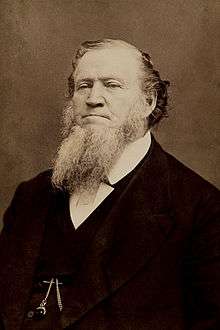
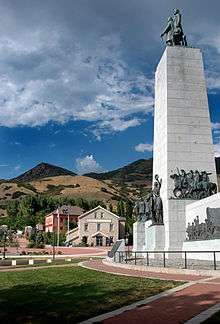
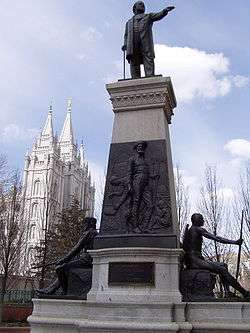
.svg.png)